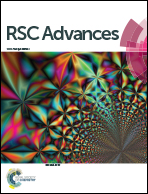Formal [3 + 3] annulation of isatin-derived 2-bromoenals with 1,3-dicarbonyl compounds enabled by Lewis acid/N-heterocyclic carbene cooperative catalysis†
Abstract
A series of novel isatin-derived 2-bromoenals were synthesized and applied in a formal [3 + 3] annulation with 1,3-dicarbonyl compounds enabled by a NHC/Lewis acid cooperative catalysis strategy. This newly developed methodology offers rapid access to functionalized spirooxindole δ-lactones. The newly synthesized isatin-derived 2-bromoenals may be further used as potential electrophilic 1,3-synthons for the diversity-oriented synthesis of spirooxindoles.
![Graphical abstract: Formal [3 + 3] annulation of isatin-derived 2-bromoenals with 1,3-dicarbonyl compounds enabled by Lewis acid/N-heterocyclic carbene cooperative catalysis](/en/Image/Get?imageInfo.ImageType=GA&imageInfo.ImageIdentifier.ManuscriptID=C5RA27848A&imageInfo.ImageIdentifier.Year=2016)

 Please wait while we load your content...
Please wait while we load your content...